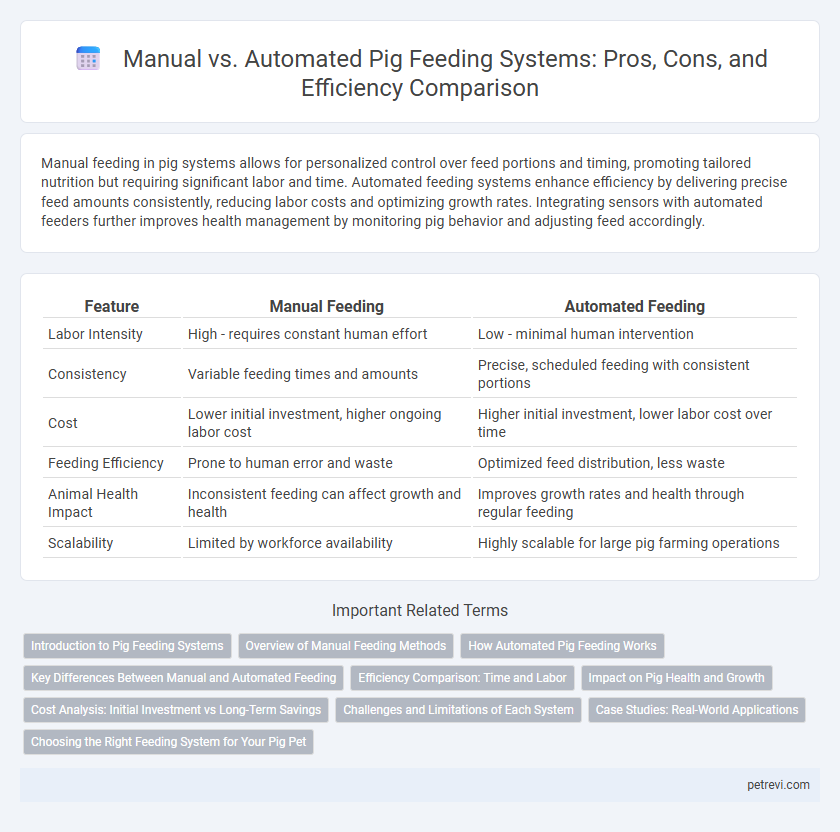Manual feeding in pig systems allows for personalized control over feed portions and timing, promoting tailored nutrition but requiring significant labor and time. Automated feeding systems enhance efficiency by delivering precise feed amounts consistently, reducing labor costs and optimizing growth rates. Integrating sensors with automated feeders further improves health management by monitoring pig behavior and adjusting feed accordingly.
Table of Comparison
| Feature | Manual Feeding | Automated Feeding |
|---|---|---|
| Labor Intensity | High - requires constant human effort | Low - minimal human intervention |
| Consistency | Variable feeding times and amounts | Precise, scheduled feeding with consistent portions |
| Cost | Lower initial investment, higher ongoing labor cost | Higher initial investment, lower labor cost over time |
| Feeding Efficiency | Prone to human error and waste | Optimized feed distribution, less waste |
| Animal Health Impact | Inconsistent feeding can affect growth and health | Improves growth rates and health through regular feeding |
| Scalability | Limited by workforce availability | Highly scalable for large pig farming operations |
Introduction to Pig Feeding Systems
Pig feeding systems range from manual to automated methods, each designed to optimize nutrition delivery and growth performance. Manual feeding requires direct human involvement to distribute feed, allowing for flexibility but demanding more labor and time. Automated systems use technology such as feeders, sensors, and timers to provide precise and consistent feeding schedules, enhancing efficiency and reducing labor costs in modern pig farming operations.
Overview of Manual Feeding Methods
Manual feeding methods in pig systems involve direct human intervention for delivering feed, allowing precise control over the quantity and timing of meals to meet specific nutritional requirements. These methods typically use tools such as buckets, shovels, or simple troughs, enabling flexibility in adjusting feed types based on the pigs' age and growth stages. Despite being labor-intensive, manual feeding helps monitor feed intake closely, reducing waste and ensuring individual animal needs are addressed.
How Automated Pig Feeding Works
Automated pig feeding systems use sensors and programmable controls to deliver precise feed quantities at scheduled intervals, optimizing growth and reducing waste. These systems monitor pig weight, activity, and feeding patterns in real-time to adjust feed distribution dynamically. Integration with data analytics enhances feed efficiency and supports healthier livestock management in commercial pig farming.
Key Differences Between Manual and Automated Feeding
Manual feeding in pig systems requires labor-intensive processes of measuring and distributing feed, which can lead to inconsistent feed portions and timing. Automated feeding systems use programmable equipment to deliver precise feed quantities at scheduled intervals, improving feed efficiency and reducing labor costs. Key differences include the consistency of feeding schedules, precision in feed distribution, and overall impact on pig growth performance and farm management productivity.
Efficiency Comparison: Time and Labor
Manual feeding in pig systems requires significant labor and time investment, often involving repetitive tasks and close monitoring to ensure accurate portion sizes. Automated feeding systems streamline this process by delivering precise feed amounts at scheduled intervals, significantly reducing labor costs and saving hours daily. Efficiency gains from automation not only enhance feed utilization but also allow farm workers to focus on other critical management activities, improving overall productivity.
Impact on Pig Health and Growth
Manual feeding in pig systems allows for personalized care and close monitoring of each animal's health, potentially identifying illness early but can be inconsistent and labor-intensive, affecting growth uniformity. Automated feeding ensures precise, consistent nutrient delivery and reduces human error, promoting optimal growth rates and minimizing stress-related health issues. Studies indicate that automated feeding systems improve feed conversion efficiency and support better overall pig health compared to manual methods.
Cost Analysis: Initial Investment vs Long-Term Savings
Manual feeding systems for pigs demand lower initial investment, requiring minimal equipment and labor costs limited to daily feeding routines. Automated feeding systems involve higher upfront expenses due to machinery and technology integration but offer long-term savings through improved feed efficiency, reduced labor, and enhanced growth rates. Cost analysis reveals that while manual feeding suits small-scale farms with budget constraints, automated systems optimize operational costs and productivity in larger commercial pig farming operations.
Challenges and Limitations of Each System
Manual feeding in pig systems often faces challenges such as inconsistent feed distribution, labor intensity, and difficulty in monitoring individual pig intake, leading to variations in growth and health. Automated feeding systems, while improving precision and labor efficiency, encounter limitations including high initial investment costs, technical malfunctions, and the need for regular maintenance to ensure accurate feed delivery. Both systems require careful management to balance feed quality, pig welfare, and operational costs effectively.
Case Studies: Real-World Applications
Case studies in pig farming reveal that automated feeding systems enhance growth rates by precisely controlling feed allocation, reducing waste by up to 20% compared to manual feeding. Farms implementing automated feeders report improved labor efficiency and consistent nutritional delivery, leading to healthier livestock populations and higher production yields. These real-world applications underscore the economic advantages and operational scalability of automated feeding technology in modern pig systems.
Choosing the Right Feeding System for Your Pig Pet
Selecting the right feeding system for your pig pet depends on balancing convenience, accuracy, and pig health. Manual feeding allows for personalized portion control and quality monitoring but requires consistent effort and time. Automated systems enhance feeding precision and schedule consistency, reducing labor while promoting steady growth and preventing overfeeding.
Manual vs Automated Feeding for Pig System Infographic

 petrevi.com
petrevi.com